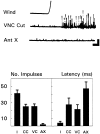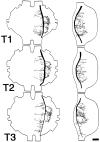Cellular organization of an antennal mechanosensory pathway in the cockroach, Periplaneta americana
- PMID: 8795635
- PMCID: PMC6578969
- DOI: 10.1523/JNEUROSCI.16-18-05830.1996
Cellular organization of an antennal mechanosensory pathway in the cockroach, Periplaneta americana
Abstract
Escape responses of cockroaches, Periplaneta americana, can be triggered by wind and mediated by a group of "giant interneurons" that ascend from cercal mechanoreceptors to motor centers. Recently it has been observed that escape also can be triggered by tactile stimulation of the antennae, and it is then independent of the giant interneurons. Here we identify a descending antennal mechanosensory pathway that may account for escape. Cobalt backfills demonstrated that a limited number of cells in the head ganglia have axons that project through all three thoracic ganglia. Comparison with known wind-sensory pathways indicated that wind is not a reliable stimulus for activating descending antennal pathways. However, direct touch stimulation of an antenna reliably evoked short-latency responses in cells with axons in the cervical connectives. Intracellular recording and dye injection revealed members of this pathway, referred to as descending mechanosensory interneurons (DMIs). The two axons of largest diameter in the cervical connectives were found to belong to DMIs, and these large-caliber interneurons were studied in detail. One had a soma in the supraesophageal ganglion, and the other in the subesophageal ganglion. Both had extensive neuritic arborizations at the same level as the soma and axonal arbors in all three thoracic ganglia. Each of these DMIs exhibited short-latency responses to small antennal movements, demonstrated a degree of directional sensitivity, and rapidly conducted impulses to thoracic levels. These cells have properties suggesting that they play a role in a short-latency behavior such as touch-evoked escape.
Figures












Similar articles
-
Correspondence of escape-turning behavior with activity of descending mechanosensory interneurons in the cockroach, Periplaneta americana.J Neurosci. 1996 Sep 15;16(18):5844-53. doi: 10.1523/JNEUROSCI.16-18-05844.1996. J Neurosci. 1996. PMID: 8795636 Free PMC article.
-
Responses of thoracic interneurons to tactile stimulation in cockroach, Periplaneta americana.J Neurobiol. 1994 Sep;25(9):1113-28. doi: 10.1002/neu.480250907. J Neurobiol. 1994. PMID: 7815067
-
An antennal-derived mechanosensory pathway in the cockroach: descending interneurons as a substrate for evasive behavior.Brain Res. 1990 Dec 10;535(2):347-52. doi: 10.1016/0006-8993(90)91623-o. Brain Res. 1990. PMID: 2073615
-
Active touch in orthopteroid insects: behaviours, multisensory substrates and evolution.Philos Trans R Soc Lond B Biol Sci. 2011 Nov 12;366(1581):3006-15. doi: 10.1098/rstb.2011.0149. Philos Trans R Soc Lond B Biol Sci. 2011. PMID: 21969682 Free PMC article. Review.
-
All in the Family - Touch Versus Olfaction in Moles.Anat Rec (Hoboken). 2020 Jan;303(1):65-76. doi: 10.1002/ar.24057. Epub 2019 Feb 27. Anat Rec (Hoboken). 2020. PMID: 30614659 Review.
Cited by
-
Complex Locomotion Behavior Changes Are Induced in Caenorhabditis elegans by the Lack of the Regulatory Leak K+ Channel TWK-7.Genetics. 2016 Oct;204(2):683-701. doi: 10.1534/genetics.116.188896. Epub 2016 Aug 17. Genetics. 2016. PMID: 27535928 Free PMC article.
-
The anatomical pathways for antennal sensory information in the central nervous system of the cricket, Gryllus bimaculatus.Invert Neurosci. 2012 Dec;12(2):103-17. doi: 10.1007/s10158-012-0137-6. Epub 2012 Jun 6. Invert Neurosci. 2012. PMID: 22669572
-
Behavioral response to antennal tactile stimulation in the field cricket Gryllus bimaculatus.J Comp Physiol A Neuroethol Sens Neural Behav Physiol. 2012 Jul;198(7):557-65. doi: 10.1007/s00359-012-0729-y. Epub 2012 Apr 26. J Comp Physiol A Neuroethol Sens Neural Behav Physiol. 2012. PMID: 22534774
-
Sensorimotor pathway controlling stopping behavior during chemotaxis in the Drosophila melanogaster larva.Elife. 2018 Nov 22;7:e38740. doi: 10.7554/eLife.38740. Elife. 2018. PMID: 30465650 Free PMC article.
-
Correspondence of escape-turning behavior with activity of descending mechanosensory interneurons in the cockroach, Periplaneta americana.J Neurosci. 1996 Sep 15;16(18):5844-53. doi: 10.1523/JNEUROSCI.16-18-05844.1996. J Neurosci. 1996. PMID: 8795636 Free PMC article.
References
-
- Arbas EA. Control of hindlimb posture by wind-sensitive hairs and antennae during locust flight. J Comp Physiol [A] 1986;159:849–857. - PubMed
-
- Bacon JP, Altman JS. A silver intensification method for cobalt-filled neurons in whole-mount preparations. Brain Res. 1977;138:359–363. - PubMed
-
- Bacon J, Möhl B. The tritocerebral commissure giant (TCG) wind-sensitive interneurone in the locust. I. Its activity in straight flight. J Comp Physiol [A] 1983;150:439–452.
-
- Bacon JP, Strausfeld NJ. The dipteran giant fibre pathway: neurons and signals. J Comp Physiol [A] 1986;158:529–548.
-
- Bicker G, Pearson KG. Initiation of flight by an identified wind-sensitive neurone (TCG) in the locust. J Exp Biol. 1983;104:289–293.
Publication types
MeSH terms
LinkOut - more resources
Full Text Sources
